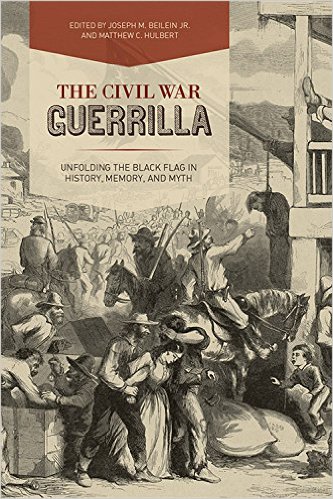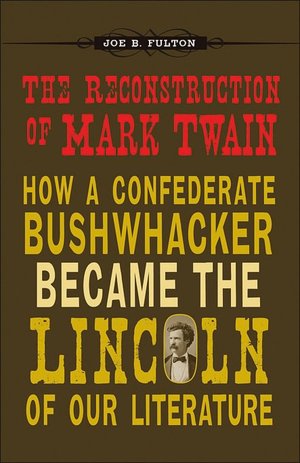The Civil War Guerrilla: Unfolding the Black Flag in History, Memory, and Myth edited by Joseph Beilein, Jr., and Matthew C. Hulbert. University Press of Kentucky, 2015. Cloth, ISBN: 978-0813165325. $50.00.
 There is little doubt that the influence of Civil War guerrilla studies is at or nearing its apex. Within the past three decades, scholars have used it as a technique with which to uncover the stories of those who died without voices. For every John Singleton Mosby operating in close proximity to enemy troops, there was a John Gatewood acting as an opportunist in the countryside. Joseph Beilein and Matthew Hulbert have compiled an anthology that addresses the complexity of guerrilla warfare during the Civil War while expanding the field into the arena of postwar interpretations.
There is little doubt that the influence of Civil War guerrilla studies is at or nearing its apex. Within the past three decades, scholars have used it as a technique with which to uncover the stories of those who died without voices. For every John Singleton Mosby operating in close proximity to enemy troops, there was a John Gatewood acting as an opportunist in the countryside. Joseph Beilein and Matthew Hulbert have compiled an anthology that addresses the complexity of guerrilla warfare during the Civil War while expanding the field into the arena of postwar interpretations.
The timing of the volume is nearly as important as the work contained therein. The past few years has witnessed a growing crescendo of works critical of the place of the guerrilla in Civil War history. Some of the field’s leading lights have authored pieces accusing those who focus on the guerrilla question of serving as a distraction to “real” Civil War history. The present volume offers a loud retort to these concerns and through the rigor and merit of the scholarship on these pages, shows skeptics what modern, innovative scholarship can be.
For their volume, Beilein and Hulbert organized a luminous cast of scholars doing innovative work. Some of the essays trend biographical and others are focused regionally, but a handful are very different from what most readers would expect. Andrew Fialka offers an essay examining spatiotemporal patterns in Missouri, effectively mapping the state’s irregular war. Such methods deserve strong consideration because of the difficulty of understanding the complexity of the guerrilla conflict. John Inscoe documents the growth of guerrilla fiction that cropped up during and after the war, giving readers a clear view of an oft-forgotten literary genre. Rod Andrew tells the story of Manse Jolly, who operated in upcountry South Carolina.
The strength of the volume is clearly in its treatment of the western theater. Both Beilein and Hulbert are specialists of Missouri’s guerrilla war, and their essays are examples of that region’s best work. Beilein and Hulbert are also scholars of the marketing of memory. Hulbert’s essay examines a narrative of the Centralia massacre and the subsequent captivity of Union soldiers and finds that there was money in both robbing banks and retelling the story. More importantly, retelling the story gave chroniclers the ability to interpret controversial events for their immediate readers and to lay a foundation for later historical interpretations.
One of the overriding themes of this volume—and of guerrilla history in general—is the powerful democracy of irregular warfare. It is the one moment when anyone can decide to pick up a gun and involve themselves in a conflict on their own terms. In the narratives that followed the Civil War, common men did not often appear. The “battles and leaders” approach told and retold stories about the commanders, their decisions, and the results. But within the realm of guerrilla history, readers can see the actions of individual soldiers through their own eyes and as witnesses to others. Hulbert and Beilein’s essayists seem to work very hard to humanize the guerrilla and permit him a level of agency not often granted in other studies.
In addition to these strengths, a couple of issues stand out as potentially problematic. First, Christopher Phillips’ foreword reads as though the book is a festschrift to Michael Fellman, but he is only mentioned six more times in the text. Without doubt, Fellman’s influence is stamped on virtually every significant piece of scholarship on Civil War guerrillas, including this one, but the foreword suggests a much greater degree of focus than the book ultimately provides. Second, the volume is very much centered on the Missouri-Kansas conflict, with only three of the nine essays, including Phillips’, set east of the Mississippi River. With a general title such as the one chosen, readers may expect a much more geographically broad book than the one they find.
Overall, The Civil War Guerrilla does not disappoint. It contains some of the field’s most innovative scholarship and important interpretations on the irregular conflict available today. Its editors have chosen their essayists well, and despite the aforementioned reservations, they have produced a lasting contribution to the fast developing field of Civil War guerrilla studies. This anthology is the first book from both Hulbert and Beilein, and the field eagerly awaits their future works.
Brian D. McKnight is the Founding Director of the Center for Appalachian Studies and Professor of History The University of Virginia’s College at Wise.

